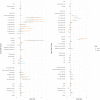Identifying individual, household and environmental risk factors for malaria infection on Bioko Island to inform interventions
- PMID: 36859263
- PMCID: PMC9979414
- DOI: 10.1186/s12936-023-04504-7
Identifying individual, household and environmental risk factors for malaria infection on Bioko Island to inform interventions
Abstract
Background: Since 2004, malaria transmission on Bioko Island has declined significantly as a result of the scaling-up of control interventions. The aim of eliminating malaria from the Island remains elusive, however, underscoring the need to adapt control to the local context. Understanding the factors driving the risk of malaria infection is critical to inform optimal suits of interventions in this adaptive approach.
Methods: This study used individual and household-level data from the 2015 and 2018 annual malaria indicator surveys on Bioko Island, as well as remotely-sensed environmental data in multilevel logistic regression models to quantify the odds of malaria infection. The analyses were stratified by urban and rural settings and by survey year.
Results: Malaria prevalence was higher in 10-14-year-old children and similar between female and male individuals. After adjusting for demographic factors and other covariates, many of the variables investigated showed no significant association with malaria infection. The factor most strongly associated was history of travel to mainland Equatorial Guinea (mEG), which increased the odds significantly both in urban and rural settings (people who travelled had 4 times the odds of infection). Sleeping under a long-lasting insecticidal net decreased significantly the odds of malaria across urban and rural settings and survey years (net users had around 30% less odds of infection), highlighting their contribution to malaria control on the Island. Improved housing conditions indicated some protection, though this was not consistent across settings and survey year.
Conclusions: Malaria risk on Bioko Island is heterogeneous and determined by a combination of factors interacting with local mosquito ecology. These interactions grant further investigation in order to better adapt control according to need. The single most important risk factor identified was travel to mEG, in line with previous investigations, and represents a great challenge for the success of malaria control on the Island.
Keywords: Importation; Malaria; Risk factors; Targeted interventions; Vector control.
© 2023. The Author(s).
Conflict of interest statement
The authors declare that they have no competing interests.
Figures




References
-
- Berzosa PJ, Cano J, Roche J, Rubio JM, Garcia L, Moyano E, et al. Malaria vectors in Bioko Island (Equatorial Guinea): PCR determination of the members of Anopheles gambiae Giles complex (Diptera: Culicidae) and pyrethroid knockdown resistance (kdr) in An. gambiae sensu stricto. J Vector Ecol. 2002;27:102–6. - PubMed
-
- Kleinschmidt I, Sharp B, Benavente LE, Schwabe C, Torrez M, Kuklinski J, et al. Reduction in infection with Plasmodium falciparum one year after the introduction of malaria control interventions on Bioko island, Equatorial Guinea. Am J Trop Med Hyg. 2006;74:972–978. doi: 10.4269/ajtmh.2006.74.972. - DOI - PubMed
MeSH terms
Grants and funding
LinkOut - more resources
Full Text Sources
Medical

